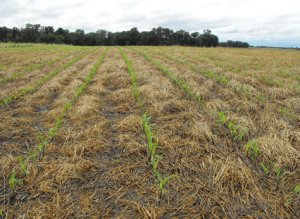Things are always changing in life, especially in agriculture, according to Jefferson County farmer Jerry Seidel. He’s seen changes on the family farm—good, bad, natural, and man-made.
Conservation, It Must Be Done
- Jerry Seidel
- Jefferson County, Illinois
Things are always changing in life, especially in agriculture, according to Jefferson County farmer Jerry Seidel. He’s seen changes on the family farm— good, bad, natural, and man-made.
The farm survived relocation changes in the 1960’s when an interstate highway cut the farm in two, severe droughts in the 1970’s and 80’s, as well as encroaching industrial development which ultimately resulted in a land swap to a bigger, much better farm relocation. Those were the days when farming just meant tillage and most everyone had livestock.
As years went by, other changes occurred on the farm. Hogs and cattle were dropped while cropland was steadily added until the farm consisted of 1,200 acres. There was also a new “awakening” that something more could be done about soil erosion. With the development of effective, affordable herbicides, tillage became a choice, not a necessity.

Jerry’s Dad, Willard, was a cautious innovator throughout his career and Jerry followed suit as he became manager of the farm. “We put in a lot of grassed waterways over the years and had pretty good success with no till beans and corn early in the 80’s and 90’s. I suppose you might have called us progressive without being on the bleeding edge,” Jerry explains.
Like everyone else, he struggled with soil erosion and gullies on the challenging soils of southern Illinois. Even after many years of continuous no-till/never till, Jerry was still dissatisfied. He knew he could do more. “Then I attended a couple of field days at “Junior” Upton’s farm where he, Mike Plumer, and Terry Taylor were writing the book on area cover crop research.
It was an epiphany moment for me. I told myself the benefits were too stunning to ignore. I must find a way to make this work on my farm. And I’ve been trying different things ever since.”
Although Jerry says his failures far outnumber his successes, he keeps learning something new every year. “It takes courage to do what I do and to try what I’ve tried, especially when you have a field right there by the road and everyone can see it,” Jerry adds.
“I’m sure I’ve provided a few bewildered laughs over the years. But I’ll keep on working on my farm to keep my farm--my soil--on my farm. And cover crops do this for me better than anything. I’ll admit it’s challenging—really hard, actually. There’s a very long learning curve but it just has to be done!”
Jerry adds, “Down here in southern Illinois, we have little topsoil to work with in the first place. We have to take care of it. We can’t just plow up some more after the top washes away. I’m always bewildered when I drive through the rich, black soils of central Illinois and see all the fall tillage. If I had just one field like that, I’d cherish it like a princess, not abuse it like a wife-beater.
Jerry takes his passion for conservation seriously; he doesn’t just do it in a vacuum. He’s served on the Jefferson County Soil and Water Conservation District board for many years.
He currently serves as Chairman. Ten years ago, he tapped into SWCD’s Conservation Practice Program (CPP) to install several more grassed waterways on his land.
He’s also made friends with technical staff at USDA’s Natural Resources Conservation Service (NRCS) and is currently signed up in the Conservation Stewardship Program (CSP). Because the entire farm is in ‘conservation mode,’ CSP was a perfect option, offering incentives and technical support from specialists at NRCS.
Using CSP, Jerry installed field borders, cover crops, and soil health improvements. “There are so many good ideas, cost-share programs, and partners out there offering ways to learn and do these things. There’s just no excuse for not making needed improvements,” Seidel explains.
On his own farm, Jerry has greatly reduced erosion and steadily watched organic matter rise. But he will tell you that he believes he has only just begun.
“There’s so much more we have to learn and do. There are so many discoveries to be made to improve cover crop seed traits, understand complex soil biology, and to successfully manage it all.”
One idea Jerry is exploring involves a tenacious weed on his farm, downy bromegrass. The species comes up in the fall after crops ripen, rapidly creates a thin durable sod, and then reseeds itself before planting time next spring.
Jerry’s idea is to find ways to use plants like that as a perennial, self-seeding cover crop, eliminating the time and expense of seeding. Just an idea he’s toying with...
According to Seidel, “Every farmer gets just so many planting seasons and so many harvests in a lifetime. Do what you can to make them all count toward leaving the land better than you found it. Don’t waste even one year.

